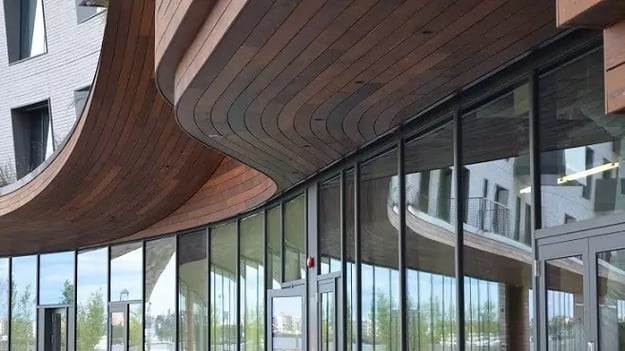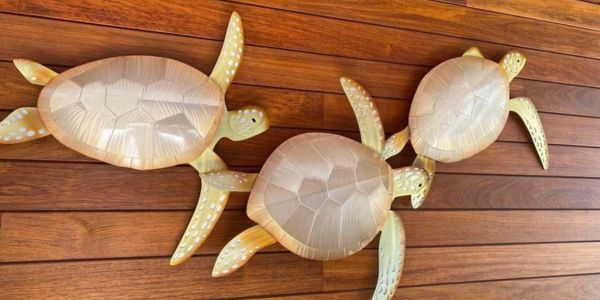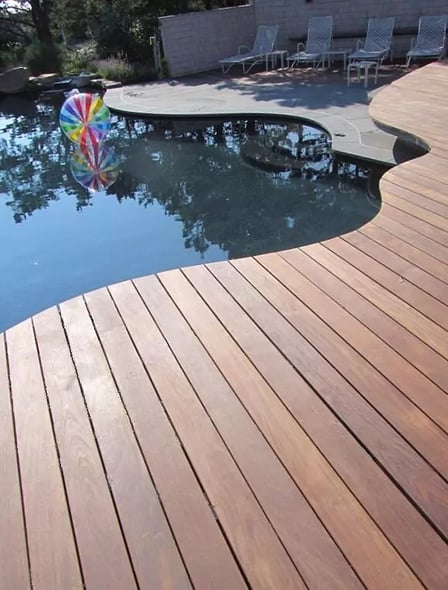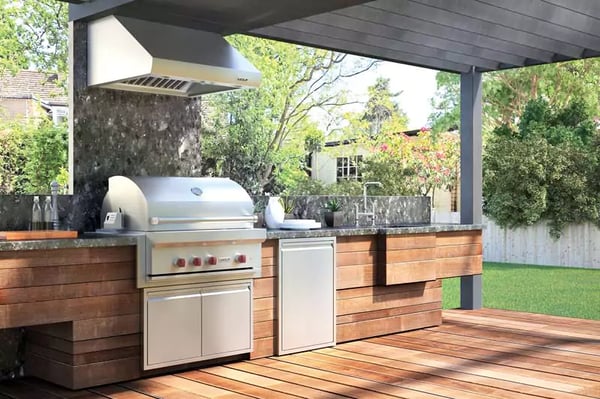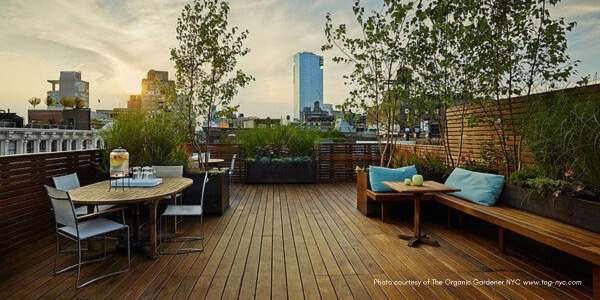
But it's not just practical – Ipe decking is also incredibly beautiful.
Ipe decking will show a range of medium to dark brown tones in the planks. Ipe requires only an oil finish containing a UV Protectant to prevent graying. The oil finish deepens and enhances the natural colors and shows off the grains. The finish should be reapplied as needed to keep the wood colors looking like new.
The rich, deep colors and unique grain patterns of Ipe make it a stunning addition to any backyard, rooftop deck, patio, or outdoor structures.
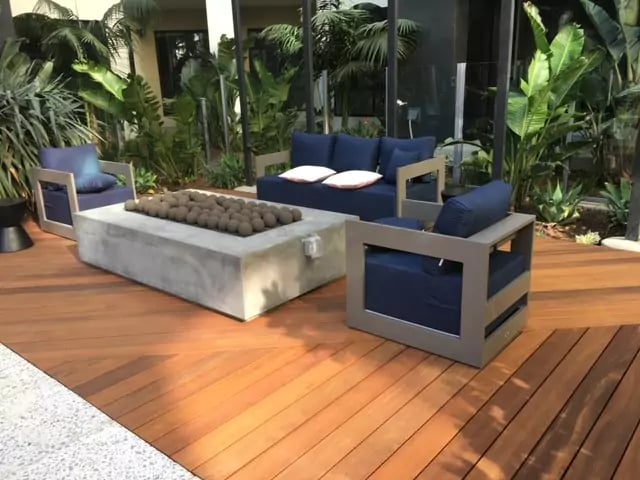 This rooftop deck design called for the Ipe decking laid out on diagonals to show off the range of tones and grains, elevating the design in a small space.
This rooftop deck design called for the Ipe decking laid out on diagonals to show off the range of tones and grains, elevating the design in a small space.
Check out this brief video overview of the Ipe color range both finished and unfinished.
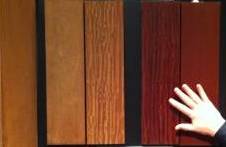
Or, Ipe can be allowed to gray naturally. It will turn a satiny silver-gray patina over time. The big benefit here, besides being gorgeous, is that it will no longer require any refinishing! Lowest maintenance option for decking yet.
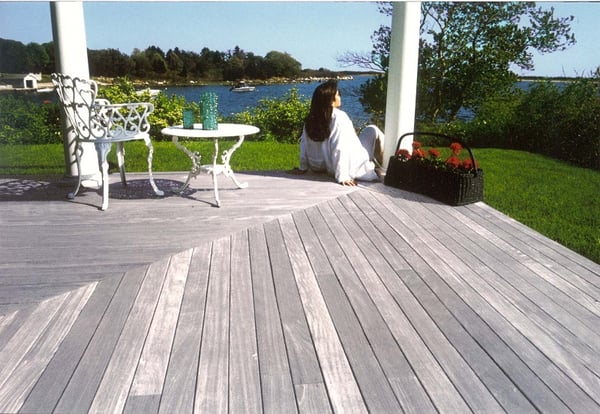 Ipe wood decking shown aged naturally to a satiny gray finish.
Ipe wood decking shown aged naturally to a satiny gray finish.
RELATED: Guide to How Exterior Woods Weather
Benefits of Ipe Decking
Ipe decking has numerous benefits that make it a top choice for outdoor decking.
Ipe's High Fiber Density Makes It Incredibly Durable
Ipe wood is one of the hardest and densest woods in the world, with a Janka hardness rating of 3,680. This means it can withstand heavy foot traffic, furniture, and even pets without showing any signs of wear and tear. Additionally, Ipe wood is resistant to scratches, dents, and marks, making it the perfect material for outdoor living spaces.
RELATED: What Is the Janka Wood Hardness Scale? @TheFamilyHandyman
Ipe is a smart decking choice for outdoor kitchens because it can handle what you throw at it.
Naturally Water and Pest Resistant
In addition to its durability, Ipe decking is also incredibly resistant to water and pests. The wood has a natural resistance to rot, decay, and insect damage, meaning it can withstand harsh weather conditions without deteriorating. While other wood decking materials may require regular treatments and sealing to prevent rot and insect damage, Ipe wood is naturally resistant. This means less maintenance and upkeep for homeowners.
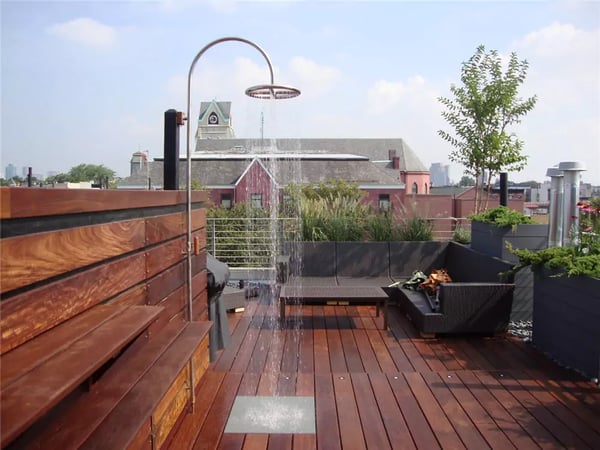 Ipe decking is has a low slippage rating and repels water naturally. Photo courtesy of @TheOrganicGardenerNYC
Ipe decking is has a low slippage rating and repels water naturally. Photo courtesy of @TheOrganicGardenerNYC
Ipe Decking vs Other Types of Decking Materials
When it comes to outdoor decking, there are many different materials to choose from, including wood, composite, and PVC. However, Ipe decking stands out from other materials for several reasons.
Firstly, Ipe decking is much more durable than other wood decking materials. While cedar and redwood are popular choices for outdoor decking, they don't have the same level of durability as Ipe wood. Composite and PVC decking materials are also popular, but they don't have the natural beauty and warmth of real wood. Additionally, composite and PVC decking materials can be prone to fading and staining over time.
For more about Ipe and other premium decking options, check out
"The Ultimate Guide to Selecting The Right Decking" now.
Durability and Maintenance of Ipe Decking
One of the biggest benefits of Ipe decking is its durability. As mentioned earlier, Ipe wood is incredibly hard and dense, making it resistant to scratches, dents, and marks. Additionally, the wood has a natural resistance to water and pests, meaning it can withstand harsh weather conditions without deteriorating.
However, while Ipe decking is low-maintenance, it still requires some upkeep to keep it looking its best. The wood should be cleaned regularly with mild soap and water to remove dirt and debris. Additionally, homeowners can choose to apply a UV-resistant sealer to help maintain the wood's rich color.
Over time, Ipe decking will age to a beautiful silver patina. While some homeowners may prefer the natural aging process, those who want to maintain the wood's original color can choose to apply a wood sealer or oil. It's important to note that while these products can help maintain the wood's color, they should be reapplied as needed to ensure continued protection.
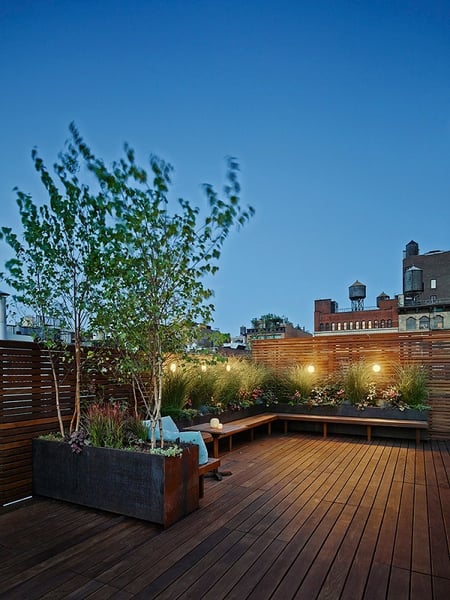 A brilliant rooftop deck using Ipe decking for the deck, built in seating, planters, and privacy wall. Photo courtesy of @TheOrganicGardenerNYC
A brilliant rooftop deck using Ipe decking for the deck, built in seating, planters, and privacy wall. Photo courtesy of @TheOrganicGardenerNYC
Sustainability of Ipe Decking
When it comes to outdoor decking, sustainability is an important consideration for many homeowners. Ipe decking is a sustainable choice for several reasons.
While other decking materials may be made from synthetic materials or harvested from unsustainable sources, Ipe is real wood. This makes it an environmentally friendly choice for homeowners who want to reduce their impact on the planet.
Firstly, Ipe wood is harvested from responsibly managed forests in South America. This means that the forests are managed in a way that promotes long-term sustainability and protects the environment. Additionally, the wood is harvested using sustainable practices, which means that only a small percentage of the forest is harvested at any one time.
Another benefit of Ipe decking is its longevity. Because the wood is so durable, it can last for decades without needing to be replaced. This means less waste and fewer resources used over time.
Finally, Ipe wood is also a renewable resource. As long as the forests are managed responsibly, the wood can be harvested indefinitely without depleting the natural resources.
RELATED: Mataverde Is Committed to Environmental Preservation
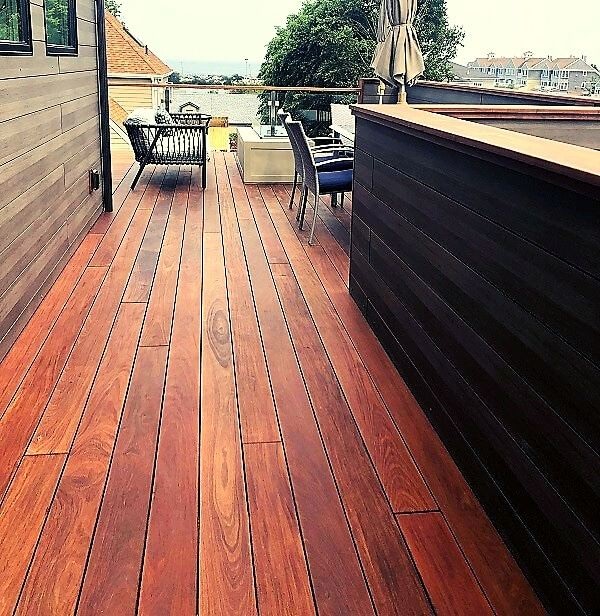 Ipe balcony deck overlooking the coastline, chosen by the homeowner because it will naturally gray and can handle salt air and storms.
Ipe balcony deck overlooking the coastline, chosen by the homeowner because it will naturally gray and can handle salt air and storms.
Design Options for Ipe Decking
Ipe decking is not only durable and low maintenance, but it's also incredibly beautiful. The wood has a rich, deep brown color and unique grain patterns that make it a stunning addition to any outdoor space. Additionally, Ipe wood can be used in a variety of design styles, from modern to rustic.
One of the benefits of Ipe decking is its versatility. This wood can be used to create a variety of design elements, including decks, stairs, railings, and even furniture. Additionally, Ipe wood can be cut and shaped to fit any space, making it a customizable option for homeowners.
When it comes to design options, homeowners can choose to leave the wood in its natural state or apply a wood sealer or oil to help maintain its rich color. Additionally, Ipe wood can be paired with other materials, such as stone or metal, to create a unique and visually stunning outdoor space.
RELATED: 150+ Deck Design Ideas eBook
Cost-Effectiveness of Ipe Decking
While Ipe decking may be more expensive than other decking materials, it's important to consider the long-term cost-effectiveness of the wood. Because Ipe decking is so durable, it can last for decades without needing to be replaced. This means less money spent on maintenance and upkeep over time.
A quick comparison of popular decking prices shows Ipe is not the most costly wood decking material:
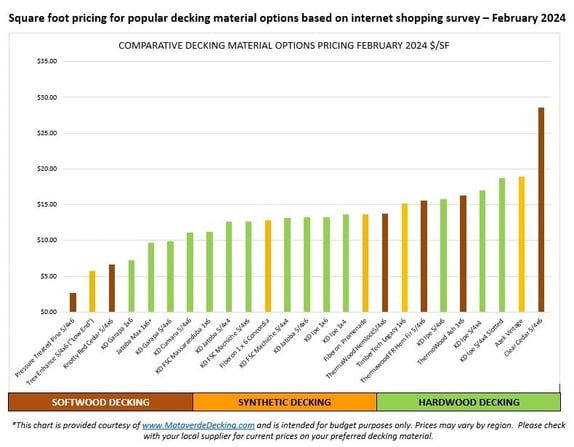
Additionally, because Ipe wood is naturally resistant to water and pests, homeowners don't need to spend money on regular treatments and sealing to prevent rot and insect damage. This can save homeowners money in the long run.
Finally, Ipe wood is also a sustainable choice for outdoor decking. While other decking materials may be cheaper, they may not be harvested from sustainable sources or may need to be replaced more frequently, leading to more waste and a higher environmental impact.
If you're looking to upgrade your outdoor space, investing in Ipe decking may be the best decision you can make. Ipe decking is incredibly durable, resistant to water and pests, and incredibly beautiful. Additionally, the wood is a sustainable choice for outdoor decking, making it an environmentally friendly choice for homeowners.
While Ipe decking may be more expensive than other decking materials, its longevity and low-maintenance requirements make it a cost-effective choice in the long run. So, if you want to create an outdoor space that is both beautiful and practical, consider investing in Ipe decking.
Related Posts
